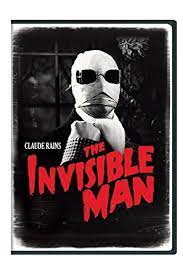
On a snowy night, there appears a stranger, his eyes hidden by dark goggles and his face swathed in bandages. He takes a room at the Lion’s Head Inn, Epping, Sussex, and demands to be left alone in his room. He makes a mess in his quarters doing chemical research and falls behind on his rent, so innkeeper Herbert Hall (Forester Harvey) comes to evict him. The stranger throws him down the stairs. When he is confronted by a policeman and some civilians, he removes his bandages and goggles and reveals that he is invisible. Laughing maniacally, he strips off his clothes, disappearing entirely, knocks people aside, and runs off into the countryside.
He is Doctor Jack Griffin (Claude Rains), a chemist who stumbled onto the secret of invisibility, and it has messed with his mind. His fiancée, Flora Cranley (Gloria Stuart), daughter of his boss, Doctor Cranley (Henry Travers), is distraught. Doctor Cranley and Doctor Kemp (William Harrigan) search his empty lab and find only a note in the cupboard. It is a list of chemicals, including monocane, which is extremely dangerous. Griffin turns up later at Kemp’s home and forces Kemp to be his visible partner in a plan to dominate the world through crime, including murder. They drive back to the inn for his notebooks and Griffin ends up killing a policeman.
Back home, Kemp calls Doctor Cranley and the police. Flora insists on coming along and under her influence, Griffin becomes less confrontational. When he discovers that Kemp has turned him in, however, he tells Kemp he will kill him at precisely 10:00 the next night. Then he goes on a killing spree, derailing a train and throwing people off a cliff. The police offer a reward, but no-one knows how to catch him. The Chief Detective (Dudley Digges) uses Kemp as bait and devises various traps. They disguise Kemp as a policeman and have him drive away in a police car. But Griffin is hiding in the back seat. He overpowers Kemp, ties him up in the front seat, and sends the car off a cliff.
A snowstorm forces Griffin to hide in a barn and he falls asleep. A farmer spots movement in the hay and calls the police, who surround the barn, setting fire to it. Griffin is forced to come out and leaves footprints in the snow. Griffin is shot and taken to the hospital. Dying, he asks to see Flora. As he dies, his body becomes visible again and the audience sees Claude Rains’ face for the first time in the movie.
The film was directed by James Whale, based on the 1897 book by H.G. Wells. In the beginning, it was supposed to star Boris Karloff. Screenwriter R.C. Sherriff signed on with James Whale. It was a money-maker for Universal and the critics raved. H.G. Wells had script approval. The special effects were ground-breaking at the time. The Invisible Man kills 122 people, more than any of the other so-called Universal monsters, but critics loved the impish black comedy in the script. Una O’Connor, the hysterical pub lady, had the cast in stitches, though I found her a bit irritating, myself. Jack’s rant to Flora about taking over the world was based on one by Benito Mussolini. Claude Rains had a habit of upstaging Gloria Stuart.
Claude Rains’ daughter first saw her father in a movie in 1950, when he took her to see The Invisible Man. It was a cold day and his face was covered by a hat and a scarf, but the ticket-seller recognized his voice immediately and offered to let them in for free, which he refused. He spent the movie explaining to his daughter how the scenes were filmed, and the other patrons in the theater ignored the movie to listen to him. His daughter didn’t see her father’s face on the screen until twenty seconds at the end. Mark Hamill said that Claude Rains’ performance influenced his own portrayal of the Joker.
